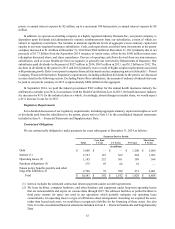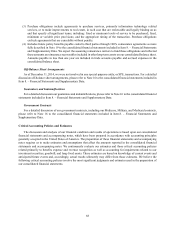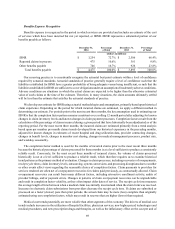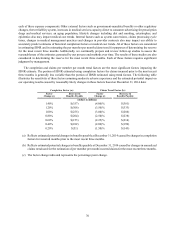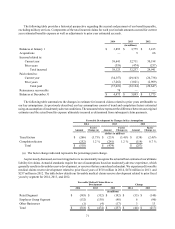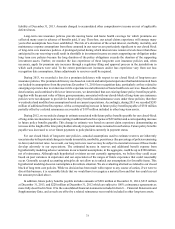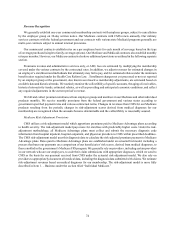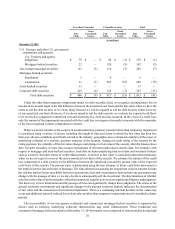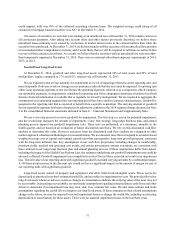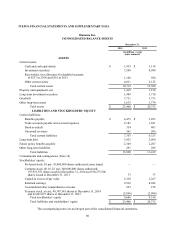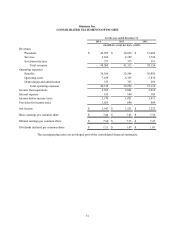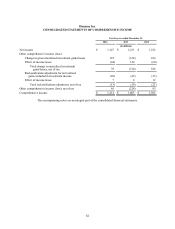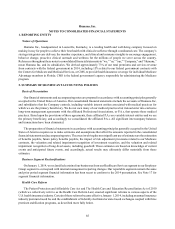Humana 2014 Annual Report Download - page 85
Download and view the complete annual report
Please find page 85 of the 2014 Humana annual report below. You can navigate through the pages in the report by either clicking on the pages listed below, or by using the keyword search tool below to find specific information within the annual report.77
credit support, with over 99% of the collateral consisting of prime loans. The weighted average credit rating of all
commercial mortgage-backed securities was AA+ at December 31, 2014.
All issuers of securities we own that were trading at an unrealized loss at December 31, 2014 remain current on
all contractual payments. After taking into account these and other factors previously described, we believe these
unrealized losses primarily were caused by an increase in market interest rates in the current markets than when the
securities were purchased. At December 31, 2014, we did not intend to sell the securities with an unrealized loss position
in accumulated other comprehensive income, and it is not likely that we will be required to sell these securities before
recovery of their amortized cost basis. As a result, we believe that the securities with an unrealized loss were not other-
than-temporarily impaired at December 31, 2014. There were no material other-than-temporary impairments in 2014,
2013, or 2012.
Goodwill and Long-lived Assets
At December 31, 2014, goodwill and other long-lived assets represented 24% of total assets and 59% of total
stockholders’ equity, compared to 27% and 61%, respectively, at December 31, 2013.
We are required to test at least annually for impairment at a level of reporting referred to as the reporting unit, and
more frequently if adverse events or changes in circumstances indicate that the asset may be impaired. A reporting unit
either is our operating segments or one level below the operating segments, referred to as a component, which comprise
our reportable segments. A component is considered a reporting unit if the component constitutes a business for which
discrete financial information is available that is regularly reviewed by management. We are required to aggregate the
components of an operating segment into one reporting unit if they have similar economic characteristics. Goodwill is
assigned to the reporting unit that is expected to benefit from a specific acquisition. The carrying amount of goodwill
for our reportable segments has been retrospectively adjusted to conform to the 2014 segment change discussed in Note
2 to the consolidated financial statements included in Item 8. – Financial Statements and Supplementary Data.
We use a two-step process to review goodwill for impairment. The first step is a screen for potential impairment,
and the second step measures the amount of impairment, if any. Our strategy, long-range business plan, and annual
planning process support our goodwill impairment tests. These tests are performed, at a minimum, annually in the
fourth quarter, and are based on an evaluation of future discounted cash flows. We rely on this discounted cash flow
analysis to determine fair value. However outcomes from the discounted cash flow analysis are compared to other
market approach valuation methodologies for reasonableness. We use discount rates that correspond to a market-based
weighted-average cost of capital and terminal growth rates that correspond to long-term growth prospects, consistent
with the long-term inflation rate. Key assumptions in our cash flow projections, including changes in membership,
premium yields, medical and operating cost trends, and certain government contract extensions, are consistent with
those utilized in our long-range business plan and annual planning process. If these assumptions differ from actual,
including the impact of the Health Care Reform Law, the estimates underlying our goodwill impairment tests could be
adversely affected. Goodwill impairment tests completed in each of the last three years did not result in an impairment
loss. The fair value of our reporting units with significant goodwill exceeded carrying amounts by a substantial margin.
A 100 basis point increase in the discount rate would not have a significant impact on the amount of margin for any of
our reporting units with significant goodwill.
Long-lived assets consist of property and equipment and other finite-lived intangible assets. These assets are
depreciated or amortized over their estimated useful life, and are subject to impairment reviews. We periodically review
long-lived assets whenever adverse events or changes in circumstances indicate the carrying value of the asset may not
be recoverable. In assessing recoverability, we must make assumptions regarding estimated future cash flows and other
factors to determine if an impairment loss may exist, and, if so, estimate fair value. We also must estimate and make
assumptions regarding the useful life we assign to our long-lived assets. If these estimates or their related assumptions
change in the future, we may be required to record impairment losses or change the useful life, including accelerating
depreciation or amortization for these assets. There were no material impairment losses in the last three years.


